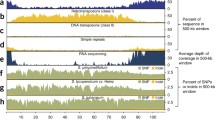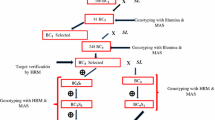Abstract
The cultivated tomato contains only a small fraction of the genetic variation present in its wild relatives. In order to use the wild germplasm in tomato breeding and genetic studies we developed a new kind of genetic resource which is composed of 50 L. esculentum lines each containing a single introgression from the green fruited species L. pennellii (LA 716). Each of the introgression lines is nearly isogenic to the cultivated tomato; these lines provide complete coverage of the wild species genome. The lines contain on the average an introgression of 33 cM from a total genome size of 1200 cM. The size and identity of the introgressed segments was determined based on RFLP analysis of 350 markers. This resource can be viewed as a genomic library of the wild species in the cultivated background. It covers the entire genome with single independent ‘inserts’ per line and therefore every phenotypic difference between the introgression lines can be associated with the unique introgressed segment. The development and potential application of this resource are discussed.
Similar content being viewed by others
References
Eshed, Y., M. Abu-Abied, Y. Saranga & D. Zamir, 1992. Lycopersicon esculentum lines containing small overlapping introgressions from L. pennellii. Theor. Appl. Genet. 83: 1027–1034.
Eshed, Y. & D. Zamir, 1994. Introgressions from Lycopersicon pennellii can improve the soluble solids yield of tomato hybrids. Theor. Appl. Genet. 88: 891–897.
Martin, G.B., G.K. Williams & S. D. Tanksley, 1991. Rapid identification of markers linked to a Pseudomonas resistance gene in tomato by using random primers and near-isogenic lines. Proc. Natl. Acad. Sci. USA 88: 2336–2340.
Rick, C.M., 1969. Controlled introgression of chromosomes of Solanumpennellii into Lycopersicon esculentum: segregation and recombination. Genetics 62: 753–768.
Tanksley, S.D., M.W. Ganal, J.C. Prince, M.C.de Vicente, M.W. Bonierabale, P. Broun, T.M. Fulton, J.J. Giovanonni, S. Grandillo, G.B. Martin, R. Messeguer, J.C. Miller, L. Miller, A.H. Paterson, O. Pineda, M.S. Roder, R.A. Wing, W. Wu & N. D. Young, 1992. High density molecular linkage maps of the tomato and potato genomes: biological inferences and practical applications. Genetics 132: 1141–1160.
Tanksley, S.D., 1993. Mapping polygenes. Annu. Rev. Genet. 27: 205–233.
Williams, J.G.K., A.R. Kubelik, K.J. Livak, J.A. Rafalski & S.V. Tingey, 1990. DNA polymorphisms amplified by arbitrary primers are useful as genetic markers. Nucl. Acids Res. 18: 6531–6535.
Zabeau, M., M. Kuiper, J. Peleman, T. Lee, R. Reijans, R. Hogers, M. Hornes, A. Frijters & P. Vos, 1994. Marker assisted breeding using AFLP. 4thIntl. Congr. of Plant Mol. Biol. (Abstr. 1844).
Author information
Authors and Affiliations
Rights and permissions
About this article
Cite this article
Eshed, Y., Zamir, D. A genomic library of Lycopersicon pennellii in L. esculentum: A tool for fine mapping of genes. Euphytica 79, 175–179 (1994). https://doi.org/10.1007/BF00022516
Issue Date:
DOI: https://doi.org/10.1007/BF00022516




